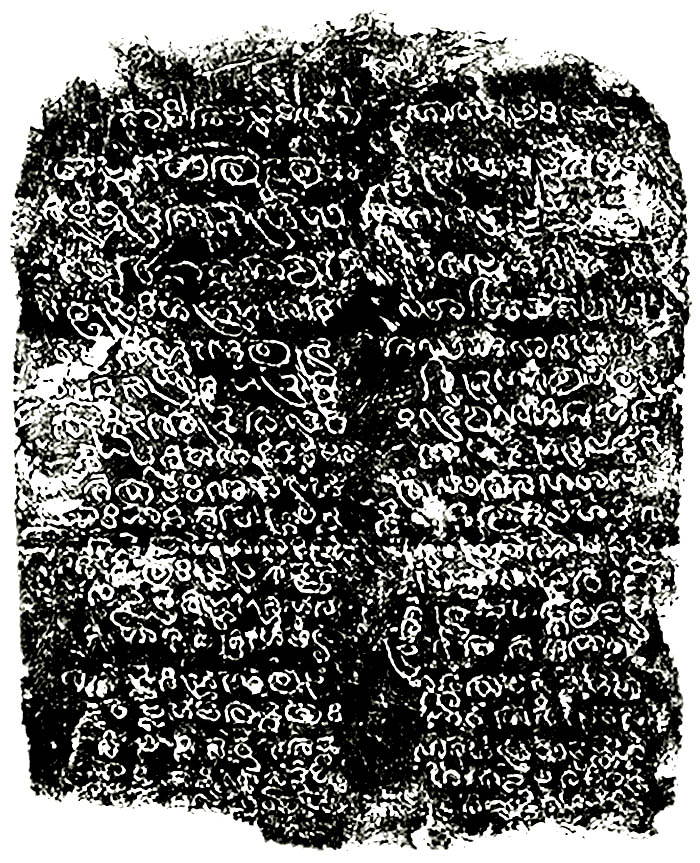จารึก
The Princess Maha Chakri Sirindhorn Anthropology Centre
ชุดคำค้น 14 คำ
อายุ-จารึกพุทธศตวรรษที่ 15, ยุคสมัย-จารึกสมัยขอมพระนคร, ยุคสมัย-จารึกสมัยขอมพระนคร-พระเจ้าหรรษวรมันที่ 1, วัตถุ-จารึกบนหิน, วัตถุ-จารึกบนหินทราย, วัตถุ-จารึกบนหินทรายสีแดง, ลักษณะ-จารึกบนใบเสมา, ศาสนา-จารึกในศาสนาพราหมณ์-ฮินดู, ศาสนา-จารึกในศาสนาพราหมณ์-ฮินดู ลัทธิไศวนิกาย, ที่อยู่ปัจจุบัน-จารึกในหอพระสมุดวชิราวุธ กรุงเทพมหานคร, เรื่อง-การบริจาคและการทำบุญ, เรื่อง-การบริจาคและการทำบุญ-ถวายสิ่งของ, เรื่อง-พิธีกรรมทางศาสนา-บูชาพระศิวลึงค์, บุคคล-พระเจ้ารุทรโลก,
จารึกบ้านตาดทอง
จารึก
![]() โพสต์เมื่อวันที่ 13 ก.พ. 2550 13:59:58 ( อัพเดทเมื่อวันที่ 21 เม.ย. 2567 22:01:01 )
โพสต์เมื่อวันที่ 13 ก.พ. 2550 13:59:58 ( อัพเดทเมื่อวันที่ 21 เม.ย. 2567 22:01:01 )
ชื่อจารึก |
จารึกบ้านตาดทอง |
ชื่อจารึกแบบอื่นๆ |
ยส. 1, Stèle de Ban Tat Tong (K. 697), K.697, กพช 10 มี.ค.23 |
อักษรที่มีในจารึก |
ขอมโบราณ |
ศักราช |
พุทธศตวรรษ 15 |
ภาษา |
สันสกฤต, เขมร |
ด้าน/บรรทัด |
จำนวนด้าน 2 ด้าน มี 47 บรรทัด ด้านที่ 1 มี 20 บรรทัด ด้านที่ 2 มี 27 บรรทัด (ด้านที่ 2 ยังไม่ได้อ่าน-แปล) |
วัตถุจารึก |
ศิลา ประเภทหินทรายสีแดง |
ลักษณะวัตถุ |
รูปใบเสมา |
ขนาดวัตถุ |
กว้าง 44.5 ซม. สูง 55 ซม. หนา 6 ซม. |
บัญชี/ทะเบียนวัตถุ |
1) กองหอสมุดแห่งชาติ กำหนดเป็น “ยส. 1” |
ปีที่พบจารึก |
ไม่ปรากฏหลักฐาน |
สถานที่พบ |
หมู่บ้านตาดทอง ตำบลตาดทอง อำเภอเมือง จังหวัดยโสธร |
ผู้พบ |
ไม่ปรากฏหลักฐาน |
ปัจจุบันอยู่ที่ |
วัดอัมพวันเหนือ หมู่บ้านตาดทอง ตำบลตาดทอง อำเภอเมือง จังหวัดยโสธร (สำรวจเมื่อ 2 กันยายน 2563) |
พิมพ์เผยแพร่ |
1) Inscriptions du Cambodge vol. VII (Hanoi : Imprimerie d'extrême-orient, 1964), 94-98. |
ประวัติ |
ตามประวัติทะเบียนจารึก ยส. 1 ของกองหอสมุดแห่งชาติ ได้บันทึกไว้ว่า ได้ขุดพบจารึกหลักนี้ ที่หมู่บ้านตาดทอง ตำบลตาดทอง อำเภอเมือง จังหวัดยโสธร ต่อมาปี พ.ศ. 2503 ได้ย้ายมาไว้ที่วัดอัมพวัน ซึ่งอยู่ในหมู่บ้านตาดทองนั้นเอง ต่อมาเป็น พ.ศ. ใดไม่ปรากฏ ได้นำมาเก็บรักษาไว้ที่วัดโพธิศรีมงคล จังหวัดยโสธร ปัจจุบันมีพระอธิการสอน วิมโล เป็นเจ้าอาวาส ซึ่งท่านได้เก็บรักษาจารึกบ้านตาดทองนี้ไว้เป็นอย่างดี เจ้าหน้าที่กองหอสมุดแห่งชาติ ได้ออกสำรวจจารึกในภาคตะวันออกเฉียงเหนือเมื่อปี พ.ศ. 2523 และได้ทำการอัดสำเนาถ่ายภาพจารึกบ้านตาดทองไว้ เมื่อวันที่ 11 มีนาคม พ.ศ. 2523 จารึกหลักนี้ ใช้ศัพท์โบราณ อันผิดจากศัพท์ที่ใช้ในปัจจุบันอยู่บ้าง เช่น ตนฺทุลํ (ข้าวสาร) ปัจจุบันใช้ ตณฺฑุลํ เป็นต้น ส่วนหลักภาษาก็คลาดเคลื่อนบ้างเล็กน้อย เช่น ททาตฺ น่าจะเป็น อททาตฺ ฉะนั้น การอ่าน-แปลครั้งนี้ จึงต้องอาศัยความหมายเป็นสำคัญ การพิมพ์ครั้งนี้อ่าน-แปลเฉพาะด้านที่ 1 เท่านั้น ส่วนด้านที่ 2 ยังไม่ได้อ่าน-แปล |
เนื้อหาโดยสังเขป |
ข้อความในจารึก เริ่มด้วยการกล่าวนอบน้อมพระศิวะ และกล่าวถึงพระเจ้ารุทรโลกว่า เป็นผู้มีความสามารถมาก ปกครองประเทศโดยธรรม ได้พระราชทานสิ่งของต่างๆ จำนวนมากแก่เจ้าชายที่เข้าพิธีมงคลสมรสกับพระราชธิดา ช่วงสุดท้ายของจารึกบอกให้ทราบว่า เจ้าชายเป็นเชื้อพระวงศ์ชาวเมืองภวปุระ และพราหมณ์ได้ทำพิธีบูชาพระศิวลึงค์ทุกวัน |
ผู้สร้าง |
ไม่ปรากฏหลักฐาน |
การกำหนดอายุ |
จารึกบรรทัดที่ 4 ได้ระบุชื่อกษัตริย์พระองค์หนึ่ง คือ “รุทฺรโลก” หรือ “พระเจ้ารุทรโลก” อันเป็นพระนามของพระเจ้าหรรษวรมันที่ 1 ซึ่งครองราชย์เมื่อ พ.ศ. 1454-1464 และพระนามนี้ได้รับเมื่อพระองค์สวรรคตแล้ว ฉะนั้นจารึกหลักนี้คงสร้างภายหลังจากที่พระเจ้าหรรษวรมันสวรรคตแล้ว |
ข้อมูลอ้างอิง |
เรียบเรียงข้อมูลโดย : นวพรรณ ภัทรมูล, โครงการฐานข้อมูลจารึกในประเทศไทย, ศมส., 2547, จาก : |
ภาพประกอบ |
ภาพสำเนาจารึกจาก : ภาควิชาภาษาตะวันออก คณะโบราณคดี มหาวิทยาลัยศิลปากร, 2545 (เลขทะเบียน CD; INS-TH-01, ไฟล์; YS_002p1) |











